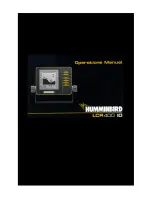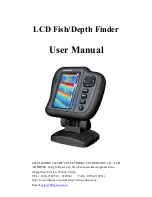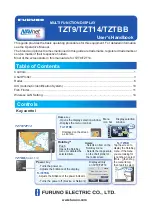
4. Put transducer in the water. The bottom of the transducer should be in a flat area
and should be in good contact with the bottom of the boat.
5. Operate the LCR with the boat operating at high speed. The transducer may have to
be moved in order to find an area where satisfactory operation is observed.
6. When an area is found that produces satisfactory operation, mark the location of the
transducer.
7. Remove the water and transducer and clean the marked area and the bottom of the
transducer thoroughly.
8. Using the Humminbird Epoxy Kit or equivalent, mix an ample amount of epoxy
without causing it to bubble and pour it in the area the transducer is to be mounted.
The puddle should be larger than the bottom of the transducer.
9. Coat the bottom of the transducer with epoxy, then put it in the center of the puddle
and push down on the transducer while moving it around in a circular motion. This
forces out any air bubbles that may be trapped between the bottom of the transducer
and the hull of the boat.
10. Let epoxy cure then the transducer is ready to operate. No water is now required in
the bottom of the boat and gas and oil that is spilled inside of the boat will not
degrade performance as it will if the transducer is placed only in water.
CAUTION: Do not use the silicone seal or any soft adhesive to bond the transducer
to the hull. This will reduce the sensitivity of the unit.
CAUTIONS
1. Occasionally the “eye“ of your transducer may become dirty from storage or from
contact with oils present in boats or marina environments. (Oil will cause the “eye” to
lose the intimate contact with the water which is necessary for efficient operation.)
The “eye” may be cleaned with liquid detergent.
2. Improper installation of the transducer can alter the efficiency and accuracy of the
entire system.
3. If your boat of transducer is out of the water for a period of time, it may take a short
period of time for the transducer to become thoroughly “wetted” when returned to the
water. Also, re-entry may cause turbulence, which will create air bubbles in the “eye”
of the transducer. The bubbles will disappear in a short time or can be removed by
rubbing the transducer “eye” with your fingers while the transducer is in the water.
4. If your instrument should fail to function, be sure to check all the electrical
connections before removing the transducer or calling a serviceman.
5. Inspect your transducer cable and make sure that it has not been cut or damaged to
the point where it will affect the performance of the transducer. A slight nick or cut,
exposing the outer cable, can be repaired by wrapping with electrical tape. A
transducer can be damaged if the inner cable and outer cable are allowed to make
contact. Such a problem can sometimes be corrected by properly splicing the
coaxial cable. This should only be attempted by a qualified service technician.
6. If your LCR is not working properly and you suspect the problem might be in your
transducer, we would recommend you borrow a unit from a friend and try it on your
boat. If the symptoms are the same, you can almost be certain that the problem is in
the transducer.
Summary of Contents for LCR 400 ID
Page 1: ......


























